Control the quality of the ingredients and the level of sweetness when you make your own homemade Tía María or Kahlúa copycat using this easy coffee liqueur recipe.
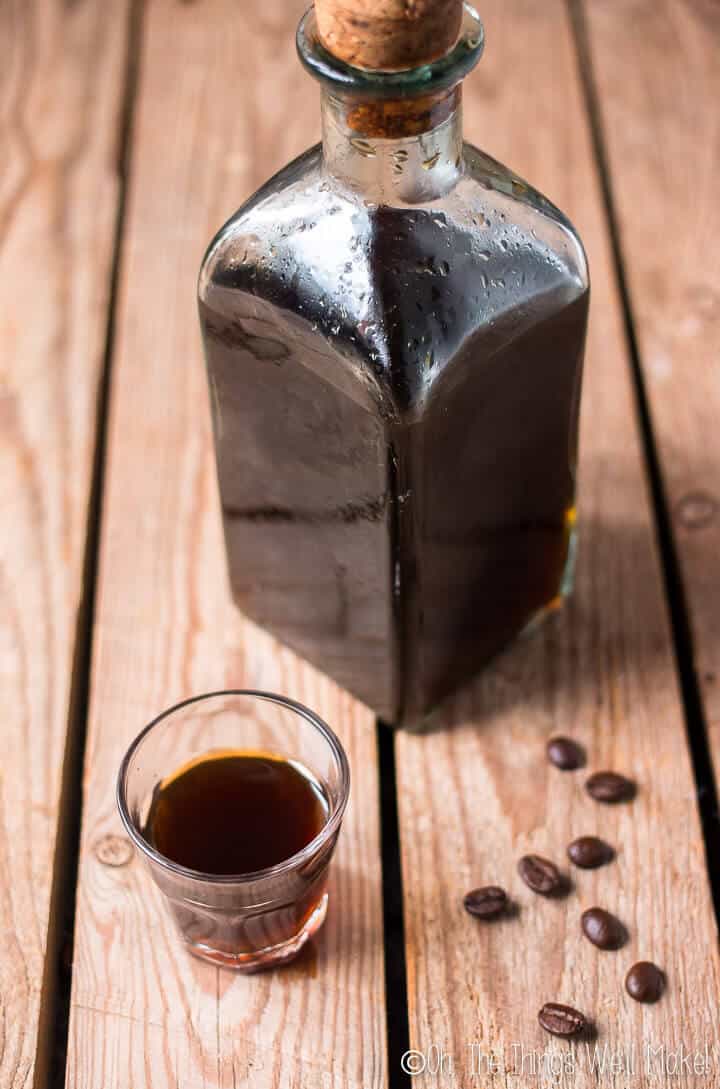
While I have been buying Kahlúa for over twenty years now, I even brought back a bottle of it directly from Mexico once, Tía María is really a new discovery for me. I’d seen recipes before that used Tea María, but, to be honest, I wasn’t even sure what it was. I figured it was some sort of liqueur, but didn’t know if it would be something like Cointreau, something “nutty” like Amaretto, or if it would be what it is, coffee liqueur.
Interestingly enough, while there are probably hundreds of cocktail recipes that use Kahlúa in the United States, it’s not so commonly recognized here in Spain. It’s so uncommon that when we tell people our dog’s name is Kahlúa (named for her beautiful coloring), most people say it’s a pretty name without having any idea that it actually means something. It’s a lot more common to find Tía María here. (And in my region of Spain, the most common coffee liqueur, Cerol, is a non-sweet, thinner coffee liqueur that gets mixed with cola or lemon soda pop to make a drink commonly known as burret.)
What got me to finally give Tía María a try?
We went to a Mexican restaurant the other night and were eyeing their collection of liqueurs when I finally got around to asking my husband what Tía María actually was. He hadn’t tried it before, despite being a huge fan of coffee liqueurs, and decided to order his after dinner coffee “tocado” with a dash of Tía María.
Once he tried it, he was hooked, and I was forced to go out and buy a bottle. First, I bought it to see if I could tell the difference between Tía María and Kahlúa, and second, to see if I could make my own version of which ever one ended up being our favorite. (Because you know I love that sort of thing, right?)
What is the difference between Tía María and Kahlúa?
Kahlúa originated in Mexico, and Tía María originated in Jamaica using Jamaican rum. Both coffee liqueurs are quite sweet and have a strong coffee flavor with a slight hint of vanilla. I find Kahlúa to be thicker and sweeter, closer to a light syrup consistency, while Tía María is lighter and smoother with a stronger hint of vanilla. Kahlúa typically has an alcohol content of around 20%, although I was surprised to find that it actually varies quite a bit from region to region, while Tía María has a set alcohol percentage of 26.5%.
From what I can tell, both liqueurs have mostly the same principal ingredients: rum, sugar (caramel), vanilla, and, of course, coffee. Kahlúa is normally said to add high fructose corn syrup to the other ingredients, which may be why it has more of a syrupy feel to it. After trying them together, both my husband and I ended up becoming coffee liqueur snobs, deciding that we no longer wanted Kahlúa, and preferred the easier to find Tía María. Our favorite Kahlúa is most definitely our cute Bernese mountain dog. 😉
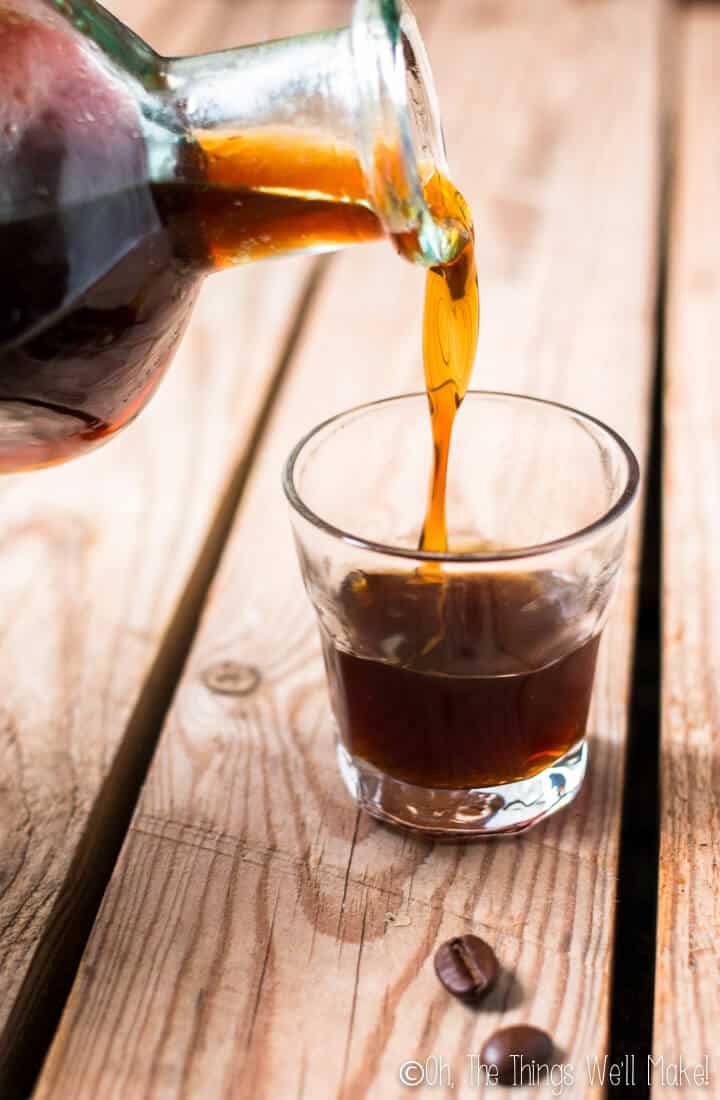
Why make your own Tía María (or Kahlúa) like Coffee Liqueur?
While you can save yourself some money by making your own coffee liqueur, that isn’t my main reason for wanting to do so. (Although now that my husband has become addicted to adding a dash of it to his coffee, being able to save a buck is a nice perk!)
The main reason I prefer to make my own coffee liqueur is to be able to control the quality of the ingredients.
When it comes to infusing things into alcohol, you are getting a pretty concentrated version of whatever it is that you are infusing. In the case of a homemade Tía María or Kahlúa, that main ingredient is the coffee, so you should make an effort to use a good quality coffee bean. Whenever I make homemade liqueurs, I always use organic ingredients whenever I can find them. That’s why I used organic mint from my garden when I made peppermint liqueur, and why I used lemons, limes, and tangerines from my own trees when making homemade limoncello, limecello, and mandarinecello!
When I made the homemade limoncello, I used a refined white sugar to keep the flavor light and to leave the liqueur a lovely shade of light yellow. In the case of this liqueur, though, I actually prefer the flavor of the more unrefined organic sugars when making the “caramel” sugar syrup. (In my first batch I used an organic panela sugar, and I think it suited the recipe quite well.)
Apart from being able to use quality, organic ingredients, by making your own, you can adjust it to suit your personal taste.
Do you like the idea of coffee liqueurs but find them to be too sweet? By making your own, you can add less sugar syrup to get a not-so-sweet version. Depending on your taste, you can give the liqueur more of a caramelized flavor by first melting the sugar over medium heat until it lightly browns, just like when you make the caramel topping for flan, or you can just make a simple syrup by dissolving the sugar in water over low to medium heat.
Do you find the alcohol content too strong or not strong enough? You can add more water to lower the percentage of alcohol, or increase it by using a thicker, more concentrated sugar solution or a rum with a higher proof to begin with. As for the strength of the coffee and vanilla, well, of course you can adjust those to suit your taste too. By letting the coffee beans infuse for more days, you can get a stronger coffee flavor. Because I love the vanilla flavor so much, I cut open 4 vanilla beans to use during the infusion process, and added one of the beans back into the bottle after filtering out the other stuff.
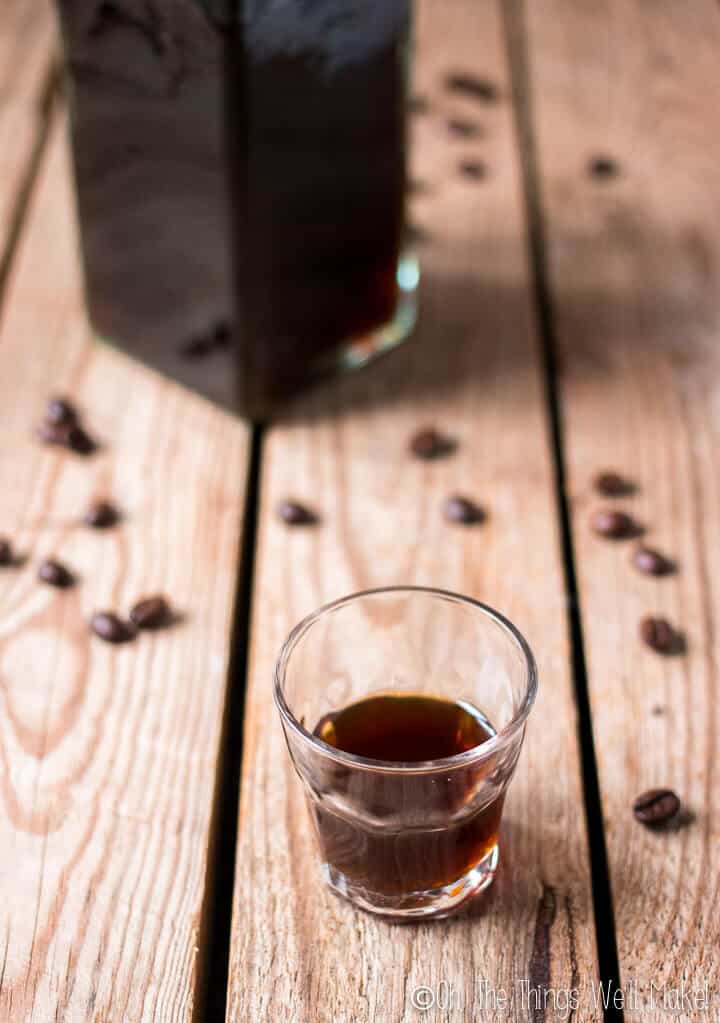
Homemade Tía María or Kahlúa Copycat Coffee Liqueur Recipe
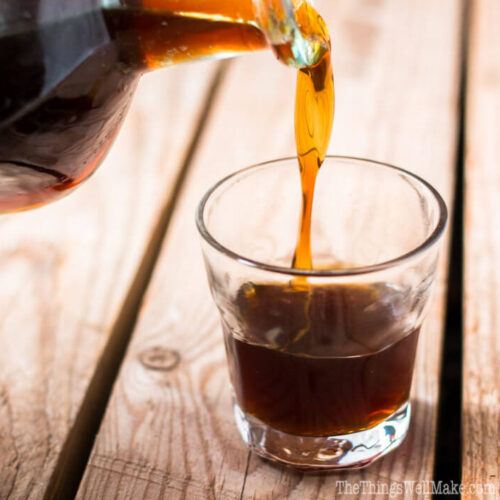
Homemade Tía María: Coffee Liqueur Recipe
Ingredients
- 25 ounces rum
- 1 cup coffee beans (whole) I chose organic
- 4 vanilla beans
- 2 cups panela or other sugar of choice
- 2 cups water
Instructions
- Find a glass bottle or jar large enough to store the rum with the coffee beans and vanilla beans for several days. Pour the rum into the container.
- Split the vanilla beans down the center with a sharp knife. This will expose the inner seeds, allowing the vanilla flavor to better infuse into the rum.
- Add the split vanilla beans to the bottle with the rum.
- Add the coffee beans to the bottle with the vanilla beans and rum, cover it, and give it a good shake. I use whole coffee beans because it’s less messy and works great, but you can also use ground coffee if you don’t have any whole beans.
- Store the bottle out of direct sunlight, shaking the bottle occasionally, when you walk by it, to help incorporate all of the ingredients so they infuse well into the alcohol.
- Depending on the strength of the alcohol used, the type of coffee, and whether it was ground or not, in just a few short days the rum will have taken on a dark color and a strong coffee flavor. You should also note the flavor of the vanilla beans, but the flavor is more subtle. At this point, it’s really up to you how long you want to leave it infusing. When you are ready to stop the process, move onto the next step.
- Make a sugar syrup. The first time I made this liqueur, I made a simple sugar syrup by mixing together the water and sugar in a pan over low to medium heat until the sugar dissolved. I used equal weights of water and sugar to make a very basic sugar syrup, but you can make it sweeter by adding more sugar, or lighter by adding less. Once cooled, add the syrup to the coffee infused rum.
- I have since been experimenting with ways to alter the final flavor of the liqueur. If you want a more caramel flavor, you can caramelize the sugar first, before dissolving it in water to make the syrup. To do so, heat the sugar, without water added, to a pan over low to medium heat until it begins to melt and lightly brown. At that point, you can add water to dissolve the caramelized sugar into a caramel flavored sugar syrup.
- Strain out the coffee and vanilla beans, and add the sugar syrup to the coffee and vanilla infused rum. It’s a good idea to add the sugar syrup little by little, tasting the mixture along the way, so that you don’t make the liqueur too sweet for your taste. Stop when you’ve reached the desired level of sweetness. (If it’s sweet enough, but too strong, you can add a little water. I’d wait a few days before adding the water, though, because the alcohol flavor seems to slightly mellow with time.)
- I wanted a stronger vanilla flavor, so I added a couple of vanilla beans back into the liqueur. Some people are very particular about not having little seeds in the final liqueur. If you want it perfectly smooth and clear of any seeds, you can do a final strain through a coffee filter or tight cheesecloth.
- Store at room temperature or refrigerated, and serve alone or in any Kahlúa or Tía María recipe. (My husband adds a dash to his espresso.) Enjoy!
 Español
Español
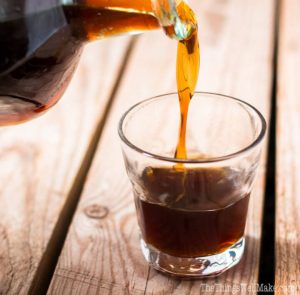
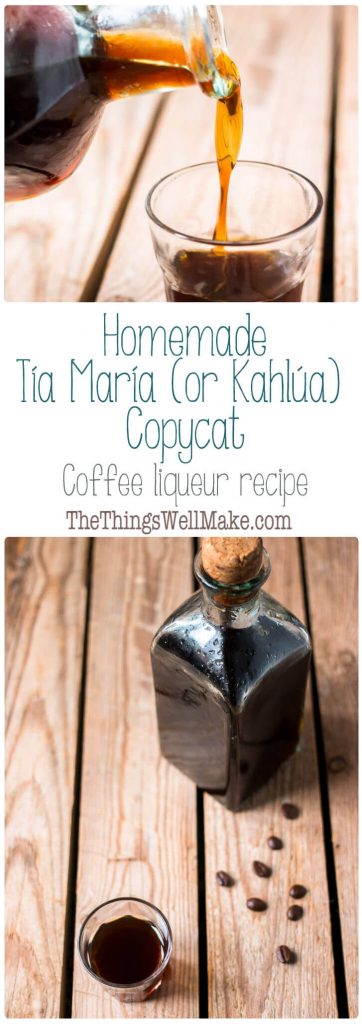
 DIY Shaving Soap Recipe (& How to Use Shave Soap)
DIY Shaving Soap Recipe (& How to Use Shave Soap)
Alex G.
Tracy, do you think if I used Palm Sugar it would work out well and Taste fine? Please and Gracias!!!
Tracy Ariza, DDS
Definitely! I love palm sugar! 🙂
Snow
Hi
Does this recipe really need sugar? Is it possible to use a natural sweetener like Erythritol?
I’m unable to consume sugar and just wondered if apart from the sweet taste, does sugar make any difference to the outcome?
Regards Snow
Tracy Ariza, DDS
Hi Snow,
Yes, you should be able to use erythritol. That’s one of the great things about making your own products.
The only differences I see is that sugar helps preserve and also may make more of a syrup consistency, more similar to the original. I’d suggest using less water, just in case. (The alcohol should preserve it fine, but try not to dilute it too much, just in case.)
Obviously, you’ll want some water to dilute the alcohol slightly so your liqueur isn’t too strong.
I used sugar here, despite rarely using sugar, because this was a copycat recipe and I was trying to get it as close to the original as possible. 😉
Jaime Barr
Can I reuse my vanilla beans to make another batch?
Tracy Ariza, DDS
Yes! Of course- you may eventually want to throw in another new bean with the rest if you find it’s not giving enough flavor.
Claire
can I swap rum for vodca?
Tracy Ariza, DDS
Yes, of course!
I used rum because it was a copycat recipe and the original uses rum.
That said, I’d imagine that with the strong flavors of the coffee and vanilla, you wouldn’t notice much difference using other flavors.
Jenny
I am wondering why you chose rum as the base of this recipe rather than vodka? I am just learnining about making liquers and am curious what flavor profiles may be better for different bases in your opinion. Thanks, I am looking forward to trying your recipes!
Tracy Ariza, DDS
Hi Jenny,
I used rum because these are copycat recipes and the originals use rum.
In my experience after making many batches of vanilla extract, with time, I don’t notice much of a difference between the various alcohols, so feel free to use what you like/have on hand!
The coffee and vanilla used will probably affect the flavor much more than the alcohol used!
Charlie
A cup of cooffee beans would be more like 100 grammes, not 10 grammes. A typo, I presume.
I’ll be making some ‘Tia Maria’ this evening.
Tracy Ariza, DDS
Oh wow! Thanks, Charlie, for the catch! I fixed it!
I had even weighed out the ingredients as I measure things out. hahaha
But, I’m not always the best at typing! 😉
Andrew
Hi Tracy, your recipe looks fantastic. Perhaps it’s the only one I can find to make coffee liqueur as good as real Tia Maria (or maybe even better). I want to make it, but I have several questions, as follows:
1. Is Panela the same as brown sugar? If I can’t find it here, can I use brown sugar instead? Will it change the flavor?
2. What coffee bean did you put in the rum? How important is the choice of the type of coffee bean in this recipe? I know I must choose good quality bean, but there so many variants, each with a different taste and aroma.
3. Is it necessary to use good white rum or any cheap white rum is sufficient?
4. I’m confused with the measurements. Did you originally use Metric or Imperial system in the recipe? Suppose this is the Imperial system, then I need 1 cup of coffee beans. But if I click to convert the cup unit to gram, the result is 10g. This is obviously incorrect because 1 cup of coffee beans should be approx. 82g. Please kindly confirm which measurement system I should follow.
Tracy Ariza, DDS
Hi Andrew,
Thank you!
1. Panela is a type of unrefined whole cane sugar that is brown in color. It may have a different flavor than what is normally sold as “brown sugar”, though, because brown sugar usually has molasses added to it. Panela doesn’t. I’d probably look for an unrefined organic demerara sugar or something like that. (I say organic because unrefined brown sugars are generally easier to find in health foods type stores.)
2. That’s a great question and one I’d love to experiment with more. To be honest, I wanted to use organic and don’t have a lot of variety for the whole beans here in Spain, so I didn’t do much research and just used what I had. I’d really like to try more varieties, though, and see how much it affects the flavor.
3. Some people will say that it makes a big difference. I’m of the opposite thinking. The advantage I see in using a good quality rum is that you won’t get as many toxins and a headache from too much of it. On the other hand, I generally pick good rums for their flavor and aroma. While they may affect the final flavor to a small amount, all of the other ingredients really mask the flavor of the rum. So, I tend to use cheaper rums and vodkas for my liqueurs and save the better stuff for cocktails or straight (not that I ever drink it straight). hahahaha
4. I’ll look into the measurements and get back to you. There may have been a typo in the recipe. I think someone else wrote me about it and I may have fixed it already. I got behind on my comments at the end of summer!
Espen Ruud
This is the recipe that looks the most promesing so far! My plan i to make a big batch for christmas gifts, but i’m aiming for a finished product in the 20% abv area. If i reduce the water-content by 25%, should i also reduce the sugar-content?
Tracy Ariza, DDS
Hi Espen,
It really depends on how sweet you want it to be. If you want it on the sweeter side, you can cook off some of the water when making the sugar syrup. By evaporating it away, your alcohol percentage will be higher. If you want it slightly less sweet, just use a smaller amount of the syrup as it. You might want to experiment with tiny amounts in small bottles or even shot glasses to compare and decide how you like it best.
sherry shorthouse
I have used instant Antigua coffee mixed in the syrup and straight alcohol from the liquor store for a less costly but tasty result. Most importantly use real vanilla beans! not extract. No hacking around the vanilla.
Jeremy Dooley
I’ve made this with whole beans (steeped for a week) and also finely crushed beans (steeped for 2 days in a coffee press (French press). The whole beans gave a smokier flavour and not as strong colour the crushed beans gave a much richer coffee flavour and not smoky which I preferred. Thanks for the recipe – it really is fantastic
Tracy Ariza, DDS
Interesting, Jeremy!
Thanks for the tip. I’ll have to experiment with that!